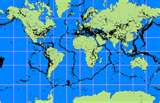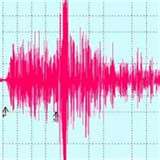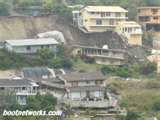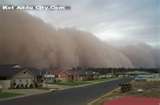About Earthquakes:
The majority of the earthquakes and volcanic eruptions occur along plate boundaries such as the boundary between the Pacific Plate and the North American plate. One of the most active plate boundaries where earthquakes and eruptions are frequent, for example, is around the massive Pacific Plate commonly referred to as the Pacific Ring of Fire. An earthquake is caused by sudden, violent shifting of massive rocks called plates under the earth's surface. This movement of the plates releases stress that accumulates along geologic faults. A fault is a deep crack that marks the boundary between two of these plates. Earthquake belts occur along faults around the world. Many run along coastal areas. The San Andreas Fault in central California is well known for causing severe earthquakes.
More About Earthquakes:

- Faults: breaks in the earth's crust where pressure is created as the two sides of the break hit each other.
- Hypocenter: the location beneath the earth's surface where the rupture of the fault begins.
- Epicenter: the location directly above the hypocenter on the surface of the earth.
The Richter Scale
This scale measures the amount of energy released from the earthquake. The intensity level runs from 0-9, 9 being the strongest. Decimals are also used. Small tremers are occuring constantly everywhere but sometimes a major earthquake happens somewhere in the world. Scientists are also researching ways to predict earthquakes but they are not always accurate.
What Comes After
Bigger earthquakes have more and larger aftershocks. The bigger the mainshock, the bigger the largest aftershock, on average, though there are many more small aftershocks than large ones. Also, just as smaller earthquakes can continue to occur a year or more after a mainshock, there is still a chance for a large aftershock long after an earthquake.
Although most of these are smaller than the main earthquake, some may be large enough to cause damage or bring down weakened structures.
An earthquake large enough to cause damage will probably produce several felt aftershocks within the first hour. The rate of aftershocks dies off quickly.
Because other effects can include fires, chemical spills, landslides, dam breaks and tidal waves, be sure to monitor your battery-operated radio or TV for additional emergency information.
A landslide occurs when soil, rocks, trees, parts of houses and other debris is swept downhill. Earthquakes, rain or general instability of the land can cause landslides.
In a mountainous terrain, landslides may occur and sometimes, small hills disappear or are leveled to the ground.
An undersea earthquake can also cause flash floods or trigger a tsunami. A tsunami is an enormous sea wave measuring over 80 feet that travels at speeds of 500 kilometers per hour. If it does crash on land, it can cause devastating damage.
Although most of these are smaller than the main earthquake, some may be large enough to cause damage or bring down weakened structures.
An earthquake large enough to cause damage will probably produce several felt aftershocks within the first hour. The rate of aftershocks dies off quickly.
Because other effects can include fires, chemical spills, landslides, dam breaks and tidal waves, be sure to monitor your battery-operated radio or TV for additional emergency information.
A landslide occurs when soil, rocks, trees, parts of houses and other debris is swept downhill. Earthquakes, rain or general instability of the land can cause landslides.
In a mountainous terrain, landslides may occur and sometimes, small hills disappear or are leveled to the ground.
An undersea earthquake can also cause flash floods or trigger a tsunami. A tsunami is an enormous sea wave measuring over 80 feet that travels at speeds of 500 kilometers per hour. If it does crash on land, it can cause devastating damage.



